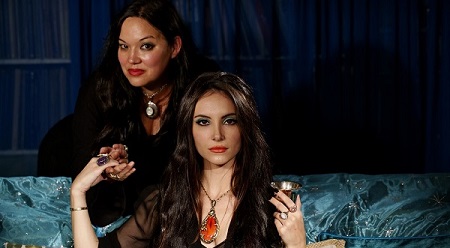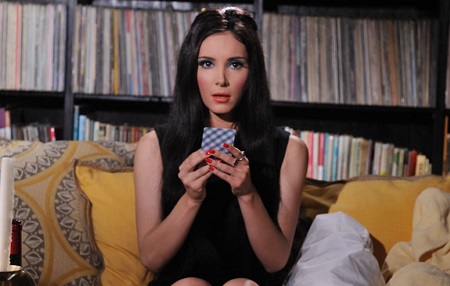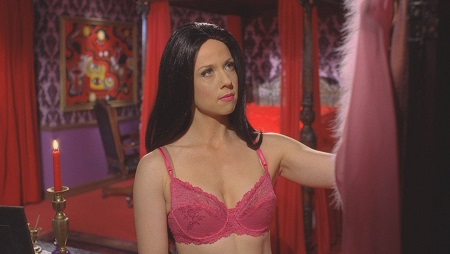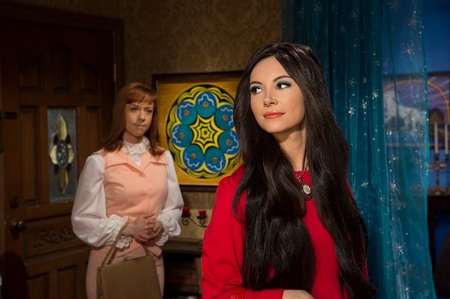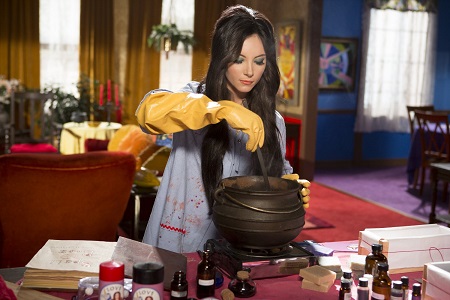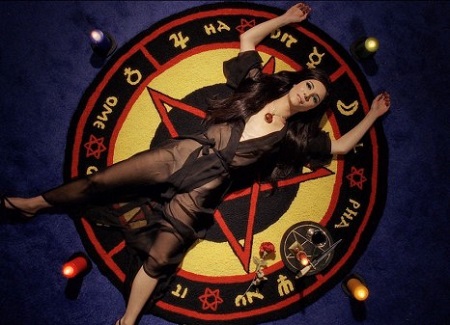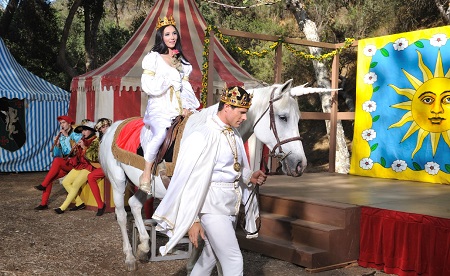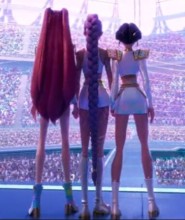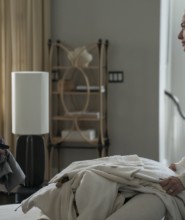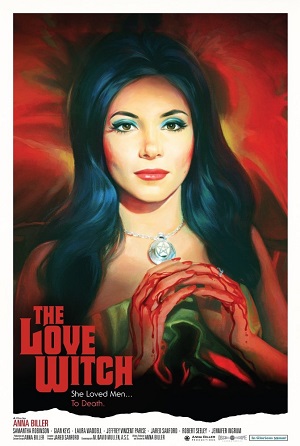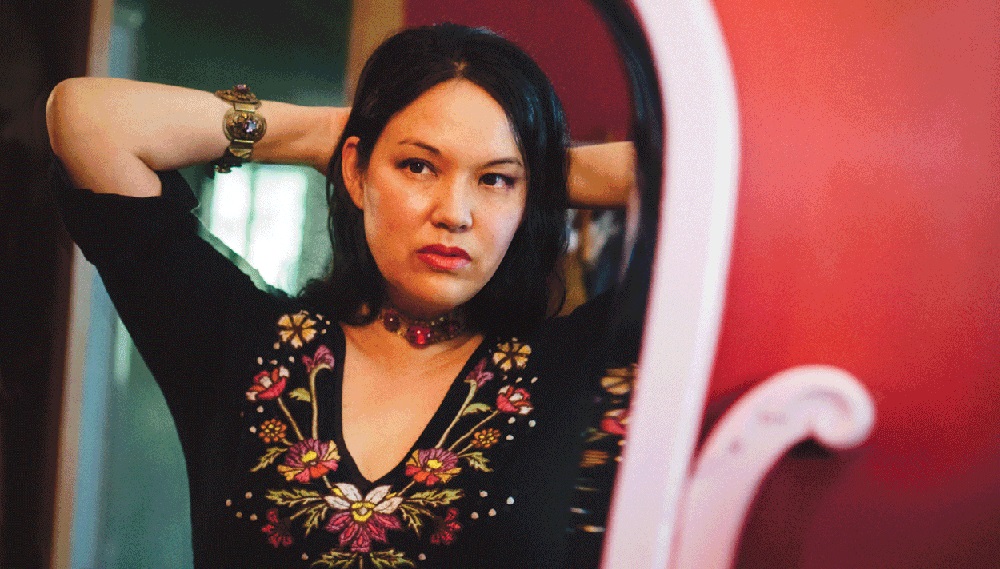
“The Love Witch” – Interview with Anna Biller
by Sara Michelle Fetters - December 2nd, 2016 - Interviews
Sympathy for the Devil
Chatting with Writer/Director Anna Biller About Her Surrealistic Feminist Throwback The Love Witch
Anna Biller seemingly does it all. Not only is she the writer and director of the acclaimed psychologically dense, visually opulent high-gloss Hitchcockian feminist throwback The Love Witch, she was also responsible for the production design, costumes, set decoration, art direction and handled the editing duties. On top of that, she also knitted a rug featured prominently in some of her feature’s most indelible images, while at the same time working closely with her star Samantha Robinson to conceive the lead character’s signature makeup looks.
With all that being the case, calling the film a labor of love for the talented auteur feels like a massive understatement. The story of a heartsick young woman, Elaine (Robinson), who just so happens to be a witch, looking for the perfect man to love, casting a bevy of spells to bring those she’s attracted to into her embrace. Problem is, when things don’t work out, all the guys have this habit of dying in her arms, leaving the beautiful, seductive sorceress with a number of bodies to dispose of in increasingly unusual ways.
I had the opportunity to briefly chat with Biller about The Love Witch, her career, feminism, gender and what it is that inspires her. Here are some of the highlights from that conversation:
Sara Michelle Fetters: Where did the ideas for The Love Witch spring from? How did all this surrealistic chaos develop?
Anna Biller: I was doing a publicity shoot for my last movie, 2007’s Viva, and I was looking at all of these romance novel covers. They were all these covers of women, nude, or in sexy lingerie, posing seductively and wearing all this makeup. I got really interested in them after that photo shoot. I also got interested in all of the witches on some of those covers. And it really just hit me. It’s when I started getting interested in doing a movie with a sexy witch.
But what happens from there? It’s at that point I have to try and develop the character. I have to make her psychologically blossom, and I typically draw from my own interests and experiences. It was key to create a realistic character, and it was a little bit later during that development when I came up with the idea that she kills, that she kills for love, and that came out of personal revelations about how men react in relationships.
From there, I start watching other movies and I draw inspiration from them. I need to figure out how to create the world this character is going to live in. What it is it going to look like? How will it feel? What will the mood be? I was also researching witchcraft, love rituals and that goes along with those things. These things were all key as far developing the film were concerned.
Sara Michelle Fetters: Elaine is such a ferociously complex character even if all we truly know about her is this male fantasy persona she has created for herself. How do you make sure she still has layers? That the audience understands that there’s something from her past that has led her to where she is now? How do you keep her from being an elegantly coifed, magnificently made-up caricature?
Anna Biller: That’s the difficulty, isn’t it? It was hard. It started with the script. Making sure I wrote in all of the little things she maybe lets slip in certain conversations, or where to place some of those sudden outburst of anger. I also spent a lot of time plotting out and planning all of those little voiceovers, making sure those conversations she’s having in her head reveal what is necessary for the character to develop but no more than that.
I think there a number of clues to what’s happened to [Elaine] sprinkled throughout. It’s all there. The pressure to continually be this male fantasy. She pushes so hard to be that fantasy, but no one can sustain that sort of artifice forever. It’s impossible. Something terrible is obviously going to happen but I think it’s also clear something equally terrible has happened in the past for her to be working overtime to be this way. It’s the constant female dilemma, right? Doing what she is doing, it can’t work out well. It just can’t.
Sara Michelle Fetters: And, it’s an interesting dynamic, isn’t it? You know Elaine is a strong character. You know she is intelligent. You know she could likely be whatever she wants. Yet, here she is, striving to be this plastic doll for men to fawn over.
Anna Biller: Because she’s damaged. And I think I make that clear from the very beginning; she’s been damaged. Someone has hurt her. And, you know, when people have been damaged, even when you’re strong, even when you’re intelligent, when you’re damaged you’re damaged, and that can lead to you making any number of bad decisions.
Elaine does have her own weaknesses, right? She’s got low self-esteem. I mean, I think any woman who puts all her work into her looks must have low self-esteem. Putting so much emphasis on looks, it’s going to kill her at some point. It’s going to make her numb. Elaine doesn’t have a core. She lost it at someplace and all of this work to perfect her outward image isn’t going to allow her to rediscover it, if she ever had one to begin with. People who just say I’m just this image and that’s all I am, they’re fundamentally ill to begin with. There’s nothing inside.
Sara Michelle Fetters: Which makes Elaine such a fascinating counterpoint to Trish, the woman who rents her an apartment and also becomes her friend, played so beautifully by Laura Waddell. She’s so drawn to Elaine, almost like she wants to be, or at least emulate, her, yet they couldn’t be any more different as far as their respective personalities are concerned.
Anna Biller: And, Trish shouldn’t want to be that way. She shouldn’t be judging herself against another woman like that. I’ve seen that so many times with women, [we] do that so much with each other. It’s weird. It’s like those women who have opposite values yet have these secret fantasies of being these glamour girls. Being Barbie Dolls. All kinds of women are just so obsessed, whether openly or secretly, with fashion models, movie stars and the like. And they would never admit it, yet here they are.
Not all women, of course, but more than you would think. There’s such a surprising amount that do that, it’s like they just can’t help it. Think of it this way in that, this is what you’ve been told your power is, that it comes from how you are looked at and perceived physically and sexually. If you’re beautiful you can have anything that you want. But it doesn’t work that way. It’s a trick. It’s a terrible trick. Women who have all that beauty, they’ll find out how much power they actually have, and it’s not nearly as much as society has told us all the believe. If that’s all you’re striving for, you’re selling yourself down. You only get a certain kind of power. It’s not real.
Sara Michelle Fetters: And isn’t that what makes Trish so fascinating? I mean, at a certain point, she discovers a different kind of power that, potentially, could be much more long-lasting and concrete. Maybe.
Anna Biller: That’s what makes her so tragic, don’t you think? She finds that power and then she loses it. I mean, she’s maybe going about it all in the wrong way. And that’s horrible! Because she’s actually fine. She’s a woman who’s never succumbed to any of society’s pressures. She’s got her head on her shoulders. She knows who she is. But then here comes Elaine and suddenly she goes there. But, that’s the idea. Anybody can go there. It’s the fantasy. It’s wanting to be the fantasy. Problem is, it’s a fantasy that cannot be maintained.
I mean, look at Elaine. She figuratively kills herself to be desirable to these men and yet none of them are worth it.
Sara Michelle Fetters: For you, Samantha and Laura, I have to imagine this had to be a lot of fun to navigate your collective way through all these craziness.
Anna Biller: It really was. For all of us, cast and crew. For Laura, specifically, she just came up with so much on her own, I didn’t have to direct her at all. The way she goes through Elaine’s room and tries on all the wigs, plays with her makeup; she just really took her time. It was really interesting. I mean, I’d worked with Samantha a lot before we filmed but I wasn’t able to work with Laura at all and I discovered she is just this totally intuitive actress, so to watch her go through everything was often amazing and I think she felt really good about it all.
With Samantha, I had to work a lot more with her because Elaine was so complicated and she was on-screen for almost the whole time. I wanted to make sure, as you asked earlier, that we got all those layers that were part of the character, but that they would all come out of her performance, and not through lines of pointless exposition. We needed to make sure she didn’t come across like a bimbo or a floozy.
Sara Michelle Fetters: It’s interesting to me that, while there are obviously sections that appear to be campy or over the top, the movie itself is neither of those things. That had to be a tricky balancing act, keeping people laughing with the movie, but not at the movie.
Anna Biller: Well, the movie is actually dead serious about the issues and that was important. There are ridiculous parts and absurd parts, and there are definitely sections that are a little over the top, but none of that was ever hopefully gratuitous.
And Samantha is just so great. We were trying to bring it all out of her, organically out of her performance. And Samantha is just so smart, she’s smart as a whip, and so we’d have these intellectual conversations constantly about [Elaine]. She had so many questions because she really wanted to get it right.
Sara Michelle Fetters: Samantha reminded me so much of Kim Novak in Bell, Book and Candle and Tippi Hedren in Marnie.
Anna Biller: Those were conscious things I put into the character. I wanted the viewer to make those connections so it’s great that you saw that. Especially in regards to Marnie. It’s just so whacked-out.
Sara Michelle Fetters: At the same time, Samantha still manages to make Elaine her own. It’s easy to make those comparisons yet the character is still unique unto herself.
Anna Biller: It’s amazing that she can do that, too. What’s incredible, is that Samantha is actually this very naturalistic type of actress, she makes everything real, and that’s what I so loved about her when she auditioned. Other actresses came in and did all this stilted, artificial throwback stuff, but nobody came in and played the character as a real person. Samantha did. It was just so natural to her, and it was what I wanted. I needed this certain style of performance but it still needed to feel natural and to feel real at the same time.
Because of that, we could have her slow down the dialogue and be so incredibly poised while delivering these long monologues in order to bring some of that old movie star style into it and yet the realism was still always there. She’s amazing.
Sara Michelle Fetters: I’d be remiss if we didn’t talk about the film’s style, if only just a little bit. I mean, how much homework did you do? Let’s not mince words, this movie looks amazing.
Anna Biller: I’ve been watching classic movies all my life. It’s my passion. So, years and years and years and years of homework. And, every time I watch a movie, I’m studying it. I experience so many different things every time I watch a movie. I’m studying the design. I’m studying the lighting. I’m looking at the writing. Just trying to sift through all these different layers. How does a movie make me feel? Why does it make me feel that way?
In my short films, I really started to learn a lot through trial and error. I could see my mistakes, and I could see how I could make things better, so I learned all these hard and fast rules that’s I’ve tried to adhere to. As far as production design and art direction, there are certain things you can do and certain things you can’t do, and you just have to figure all of that out. So much is dependent on how you light things as well, which also then influences how you design the costumes. You just need to find a way for it all to come together, figure out that choreography.
Sara Michelle Fetters: Watching the film with an audience, I think my favorite reaction is when someone pulls out a cell phone for the first time.
Anna Biller: Right! I know! It’s so crazy. People are so drawn into the rear projection, and the lighting on Samantha’s face, and the sets and the costumes, it’s like they just assume it’s an old movie. But, one of the very first shots in the film we see all of these modern cars. For that matter, Trish is driving a brand new BMW. There are computers. It’s so interesting, because the audience has seen all of that already, but for some reason none of that has registered until she pulls out that cell phone. It’s so strange.
Sara Michelle Fetters: But you also made most of Elaine’s costumes yourself. And, didn’t you knit or make that big rug that’s part of one of the film’s most iconic images?
Anna Biller: I did! I hooked that big pentagram rug myself. It was just so important to me to have Elaine laying on this big pentagram, and it just didn’t feel right to me to paint this big piece of canvas or something and throw it down on the floor. Nobody would do that! It didn’t fit Elaine’s character. I wanted her to lie down on a pentagram, but on a carpet, that image just seemed so incredible to me. So, it was like, how do you make a rug? You have to hook it. It was like the first thing I made for the movie because I knew I wanted that shot, and the only way I was going to get it was if I made the rug myself.
Sara Michelle Fetters: Let’s talk about the cinematography. What challenges did you present to David Mullen? How do you think he did? I mean, if this was a fair and just world, and we were honestly talking about cinematography awards as if all films were on an equal playing field, he should be part of that conversation. His work here is just incredible.
Anna Biller: You’re right. He should be. He’s such a genius. I’d worked with him before on some of my short films and we have just similar tastes, and we have almost the exact same vision because we watch a lot of the exact same films.
I’ve had lots of clashes with DPs over the years because I always want this style of lighting and some people just don’t get it. I’ve almost had to become a DP, because I’ve had to learn all the terminology in order to get the look that I want, and it allows me to not totally stress out if somebody doesn’t know all that I feel like they should. And that’s what makes David so amazing. He knows it all. There’s no language barrier and he’s absolutely fearless to try new things.
Sara Michelle Fetters: Got to say, if I was going to hire someone to make a Douglas Sirk-style movie now, it would have to either be Todd Haynes or you as I’m pretty certain few others could pull it off.
Anna Biller: Oh, there could probably be other filmmakers if they wanted to do it. Problem is, no one wants to work in that sort of style. But, then, a lot of filmmakers don’t know how to achieve that kind of high-gloss look. They don’t know that it comes down to lightning. When I interview DPs and I ask about this sort of lighting, they always want to change the subject. When they change the subject, I know they don’t know what they’re doing or how to pull this sort of look off. I want to talk about the lighting and they want to talk about the lensing. They just don’t get it.
Dennis, he is so smart. He’d bring to set a bunch of his grandmother’s old silk stockings in order to create some of those amazing lighting effects. He’d put Vaseline on the lens. He’d do all these amazing things. He’d use black tape to create a windowpane shadow. All this stuff I’d never have thought of! It’s just so great.
Sara Michelle Fetters: Do you think people, when they watch the movie, take the time to listen to all it is you are trying to say? About romance. About gender. About gender relations. About all of these different themes and ideas that populate this film. Do you worry that it all might be coming at them in a way that they are maybe not quite ready for?
Anna Biller: I don’t know. It’s hard to say. What I’ve noticed is that women are picking up on it all. They get it. They get it right away. What I’ve noticed with men is, if their desire is involved, they actually can’t seem to see anything else. They’re blind. If they’re aroused at all? That’s it. They end up missing the point. It’s like a debased movie because it arouses their lust, which is so funny, and also part of the point, don’t you think?
Sara Michelle Fetters: Is it unfair to say Elaine is villain? Would it be more unfair to say she is hero? Can she be a little bit of both?
Anna Biller: I don’t think of her as a hero or a villain. She’s not a hero because she’s really, really shitty to an awful lot of people. She’s really terrible to Trish. She ruins her life. So she’s not a hero.
But is she a villain? Well, she kind of is for that stuff, I guess, but she’s also a victim, a victim of the patriarchal world she lives in. So, in that way, Elaine is just like a regular person. There are things to admire about her even if she is deeply, deeply flawed. She’s really kind of everywoman, which might sound odd considering she’s such an odd character. You can understand her impulses. You can sympathize with her.
Sara Michelle Fetters: Next Halloween, if there are people running around in Elaine costumes, will that bring a smile to your face?
Anna Biller: It already happened! I had people sending me emails and pictures, asking me if they got their makeup right. It was pretty great. Surreal, but great.
Sara Michelle Fetters: At the end of the day, what do you hope people are talking about when they exit the theatre?
Anna Biller: All I can really hope for is that people are entertained. I don’t expect much more than that. You can’t tell people how they are supposed to feel. What some people do when they watch the movie is they project themselves into it, and I think that’s neat. I think that’s what people should be doing. You make a movie, once it gets out there, it’s no longer about me, it’s about the viewer. It has to be able to take whatever it gets from them. That’s how it is. That’s also how it should be.
– Interview reprinted courtesy of the SGN in Seattle
